Mid Travel / Long Travel Tech Thread
#81
Senior Member
#82
Just so you know the lift has to come off for the Brenthel lt kit. i would do tons of research on lt kits before pulling the trigger on one anytime soon. There is actually an option to have lt and a lift together and that's the dirt King bolt on kit with custom length coilovers. That's my plan right now and it should be pretty sweet.
#83
Just so you know the lift has to come off for the Brenthel lt kit. i would do tons of research on lt kits before pulling the trigger on one anytime soon. There is actually an option to have lt and a lift together and that's the dirt King bolt on kit with custom length coilovers. That's my plan right now and it should be pretty sweet.
#84
Senior Member
Thread Starter
Here is a 3.0 comparison: http://www.fordraptorforum.com/showthread.php?t=23405
Front Stock Fox vs Fox 3.0 vs Icon 3.0 vs King 3.0: Dyno Results Testing Generals Finding a dyno to do these tests is no small thing, and even then finding one owned by a group willing to let you use it is an entirely different thing. Without getting crazy technical, most dynos are not large enough to handle the full range of travel and force levels these shocks can produce. The equipment used in these tests was custom built and specifically designed to help develop test and tune many of the best off road shocks the world has ever seen. In terms of the actual tests being carried out, extreme care was taken to ensure consistent conditions and procedures between tests and shocks.
Testing Specifics -There were 3 main categories of tests run on each shock: (1) Hardware and Length Observations and Measurements, (2) Spring Rate and Ride Frequency, and (3) Velocity Cycle testing. The first two are conducted using precise measuring instruments and math to find various lengths at given positions as well as ratios and factors. The last one uses the dyno's abilities to apply force and velocity, and to measure the same throughout the cycle. -The stock Fox, Fox 3.0, ICON 3.0, and King 3.0 Raptor shocks tested were all "brand new out of the box", and were of current production as of January 2013. -All shocks where tested at ambient room temperatures (approx 72deg F).
See post #57 for a discussion as to why. Results 1) Hardware and Length Observations and Measurements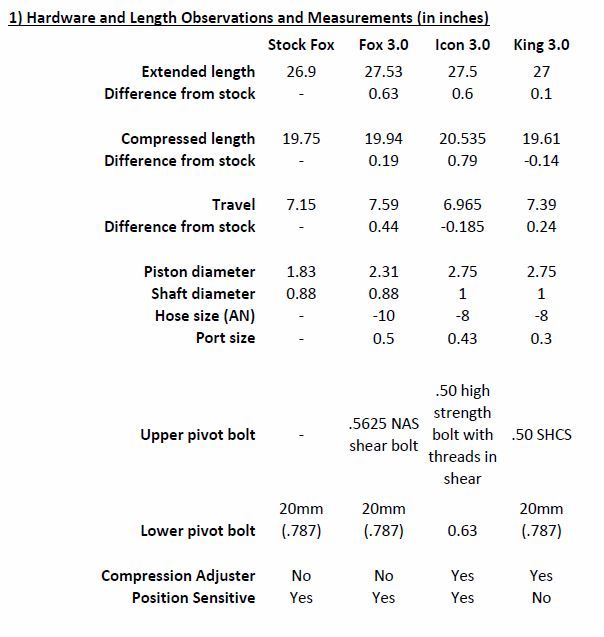
Details: "Extended length" measures the overall length of the shock when extended as far as it will go. "Compressed length" measures the overall length of the shock when it has compressed as far as it will go. "Travel" is the subtraction of "Extended length" minus "Compressed length"; this tells us how far the shock can move from one end of its stroke to the other. "Piston diameter" measures the diameter of the piston, "Shaft diameter" measures the diameter of the piston shaft, and "Hose size" is the AN size of the hose. "Port size" measures the diameter of the port between the shock body and the hose that connects to the reservoir. "Upper" and "Lower pivot bolts" describe the size and type of hardware used to connect the shock to the truck, and "Compression Adjuster" and "Position Sensitive" are observations made about the shock's features.
Notes and comments:
1a) The King shock has the shortest compressed length; even shorter than stock. This means the King shock has the most "bump travel"; in other words, the King will travel further during its compression stroke, which means the tire is moving further up into the wheel well and may come into contact with the fender lining. On the other hand, the ICON has the longest compressed length, meaning the shock will travel almost one full inch less 'up' into the well, than will the Kings. 1b) The ICON and Fox 3.0 shocks effectively allow for the same (most) 'down' travel, which will result in the tire staying in contact with the ground longer than the other options. 1c) Unlike the other three options, the Kings are not position sensitive shocks, just velocity sensitive. This essentially means internally to the shock, the damping force is the same for a given velocity regardless of where the shock is in its stroke. The King has a user-settable external compression adjuster to restrict fluid flow into the reservoir. The ICONs are position sensitive and have an external compression adjuster.
2) Spring Rate and Ride Frequency Measurements "Spring Rate" measures the amount of weight needed to compress a spring a certain distance. In this case, the following data is in terms of "how many pounds does it take to compress the spring one inch?" and is denoted as lb/in. The Stock Fox springs compress at a rate of 525-550lb/in. The Fox 3.0 springs compress at a rate of 550lb/in. The ICON 3.0 springs compress at a rate of 675lb/in. 19% stiffer than stock The King 3.0 springs compress at a rate of 600lb/in. 10% stiffer than stock "Ride Frequency" is a calculated value used to help compare various aspects of suspension systems across vehicles. It's found by crunching spring rate, motion ratio, and corner weight through a mathematical black box (the details of which are beyond the scope of this discussion). The numbers of several vehicle types, as well as these shocks are offered here to help provide some perspective.
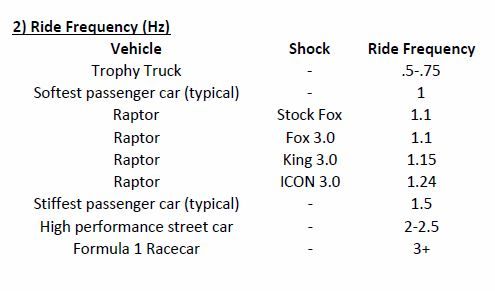
Notes and comments:
2a) The lower the "spring rate" (the less weight it takes to compress the spring one inch), typically the better for off road applications since it indicates the spring will be more compliant, or forgiving. The less weight it takes to move the spring, the softer that rock in the road will feel. The term "better" here is very subjective, however, since we all have different ideas about what feels best to us. 2b) As you can see by the comparison, those cars that really need to corner like they're on rails will typically opt for a larger ride frequency, while those tasked with absorbing the biggest hits will opt for a system resulting in a lower ride frequency. You decide where you feel most comfortable on the scale.
3) Velocity Cycle Testing WARNING: This is about to get real technical (relatively speaking). The goal with this test was to compare how the "position sensitivity" of each shock behaves. In a nutshell, that means cycling the shock and measuring the forces as it makes its way back and forth through each zone. There are many ways to test this, but for our purposes and to keep things as simple as possible: -a "square wave input" setting was used on the dyno -the ICON and King shocks' compression damper adjusters were tested at both fully open and fully closed (and not in between). You can effectively infer what the graph would look like in between these extremes. -the graphs are at 10" per second velocity to show the general shape, denoted as in/s. -the ends of the curves have some fluctuation due to the acceleration and deceleration of the dyno itself A note regarding how to read the graphs: The compression stroke is on the bottom and shown as negative numbers. Rebound is on top and shown as positive numbers. "Shock displacement" or stroke (travel) is in the X axis (inches) and force generated by the shock is on the Y axis (pounds) Another note: the Fox 3.0s show a range of .75" more than the ICON and Kings.
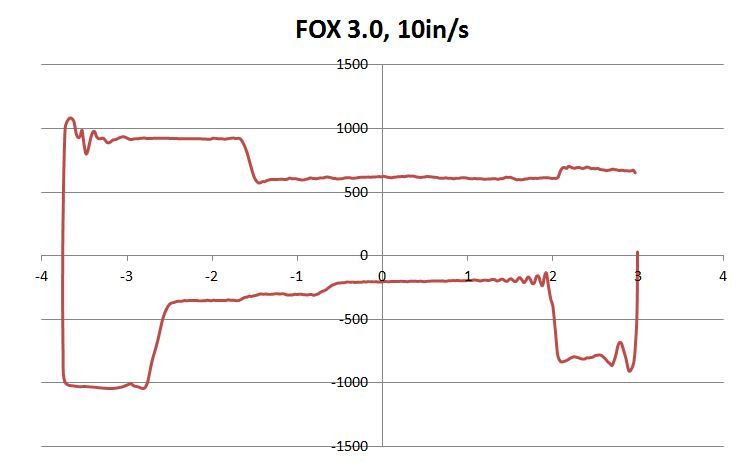
The Fox 3.0 has 3 rebound zones, and 4 compression zones. On the rebound side, the shock generates less force at ride height and more force at both ends of travel. On the compression side the force increases in stages before hitting the final zone.
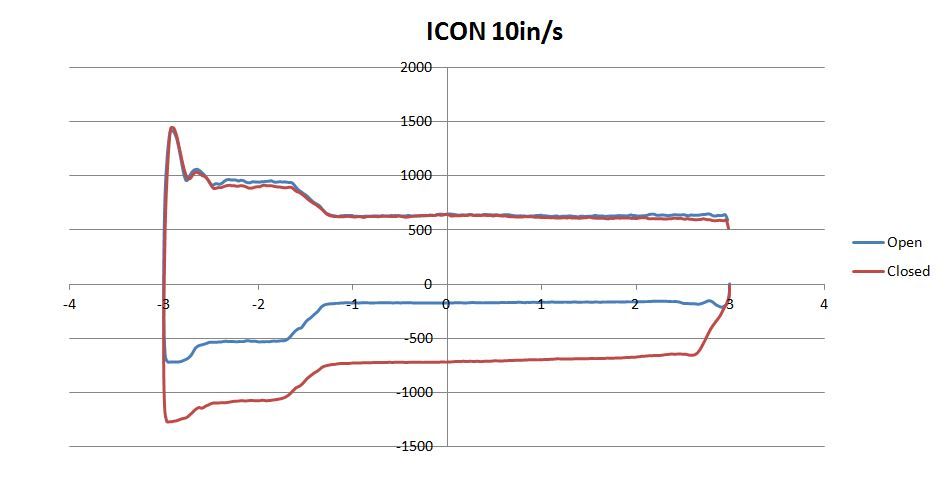
The ICON 3.0 has 3 rebound zones and 3 compression zones. The transition is effectively instantaneous as the secondary piston engages the bottom out cup. This allows for more bottom out control and "rebound stick" when compared to a mono-tube shock.

The King 3.0 is a mono-tube shock with no position sensitivity (1 rebound zone, and 1 compression zone). The forces are the same throughout the travel. Here they are plotted to show rebound Force vs Velocity at ride height
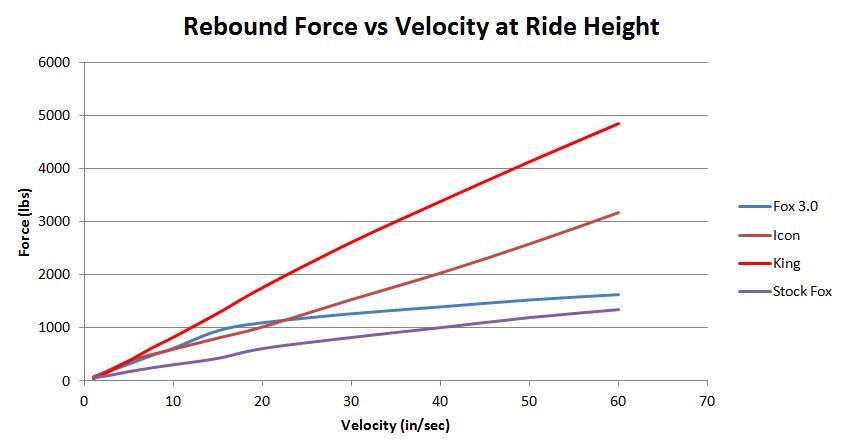
Here they are plotted to show compression Force vs Velocity at ride height
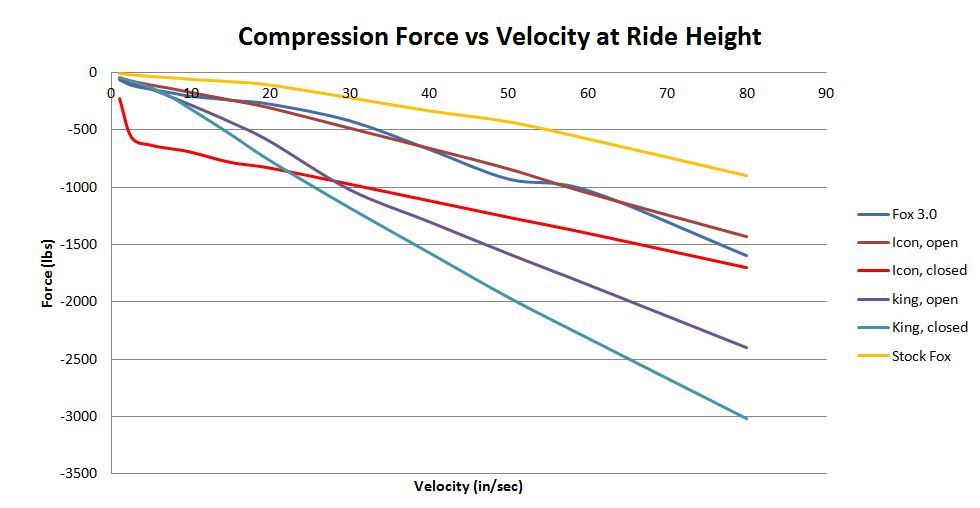
And here they are plotted to show compression Force vs Velocity within the bump zones
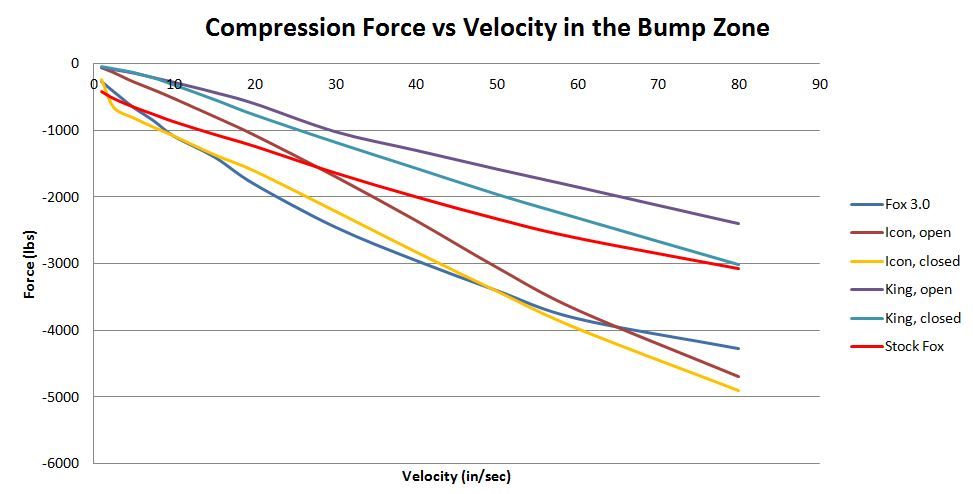
3a) The theory goes, for off road applications, the more zones the better. The idea being each zone will allow for a step up/down of the force, and therefore allow for less dramatic transitions between travel extremes. The upshot of that approach is more control over the entire travel of the shock because the responses are more gradual. Although, there is clearly a point of diminishing returns; in other words, how many zones do our shocks/trucks really need given your driving style and goals? I leave it to the reader to decide for themselves how many zones is enough for them. 3b) Generally speaking, when tuning for off road vehicles, the rebound forces are kept low to allow for the wheels to "droop out" (move 'down') easier which in turn keep the tires in contact with the ground longer resulting in more traction. "Packing up" is also minimized when hitting multiple successive bumps when rebound forces are minimized. 3c) Generally speaking, when tuning for off road vehicles, the goal is to keep compression (damping) forces at ride height low, to allow the suspension to move freely 'up' with small bumps resulting in a "smoother" ride. 3d) Unlike when at ride height, when in the bump zone generally speaking the goal is to maximize the force to prevent bottom outs while still within the full travel of the shock.
Testing Specifics -There were 3 main categories of tests run on each shock: (1) Hardware and Length Observations and Measurements, (2) Spring Rate and Ride Frequency, and (3) Velocity Cycle testing. The first two are conducted using precise measuring instruments and math to find various lengths at given positions as well as ratios and factors. The last one uses the dyno's abilities to apply force and velocity, and to measure the same throughout the cycle. -The stock Fox, Fox 3.0, ICON 3.0, and King 3.0 Raptor shocks tested were all "brand new out of the box", and were of current production as of January 2013. -All shocks where tested at ambient room temperatures (approx 72deg F).
See post #57 for a discussion as to why. Results 1) Hardware and Length Observations and Measurements

Details: "Extended length" measures the overall length of the shock when extended as far as it will go. "Compressed length" measures the overall length of the shock when it has compressed as far as it will go. "Travel" is the subtraction of "Extended length" minus "Compressed length"; this tells us how far the shock can move from one end of its stroke to the other. "Piston diameter" measures the diameter of the piston, "Shaft diameter" measures the diameter of the piston shaft, and "Hose size" is the AN size of the hose. "Port size" measures the diameter of the port between the shock body and the hose that connects to the reservoir. "Upper" and "Lower pivot bolts" describe the size and type of hardware used to connect the shock to the truck, and "Compression Adjuster" and "Position Sensitive" are observations made about the shock's features.
Notes and comments:
1a) The King shock has the shortest compressed length; even shorter than stock. This means the King shock has the most "bump travel"; in other words, the King will travel further during its compression stroke, which means the tire is moving further up into the wheel well and may come into contact with the fender lining. On the other hand, the ICON has the longest compressed length, meaning the shock will travel almost one full inch less 'up' into the well, than will the Kings. 1b) The ICON and Fox 3.0 shocks effectively allow for the same (most) 'down' travel, which will result in the tire staying in contact with the ground longer than the other options. 1c) Unlike the other three options, the Kings are not position sensitive shocks, just velocity sensitive. This essentially means internally to the shock, the damping force is the same for a given velocity regardless of where the shock is in its stroke. The King has a user-settable external compression adjuster to restrict fluid flow into the reservoir. The ICONs are position sensitive and have an external compression adjuster.
2) Spring Rate and Ride Frequency Measurements "Spring Rate" measures the amount of weight needed to compress a spring a certain distance. In this case, the following data is in terms of "how many pounds does it take to compress the spring one inch?" and is denoted as lb/in. The Stock Fox springs compress at a rate of 525-550lb/in. The Fox 3.0 springs compress at a rate of 550lb/in. The ICON 3.0 springs compress at a rate of 675lb/in. 19% stiffer than stock The King 3.0 springs compress at a rate of 600lb/in. 10% stiffer than stock "Ride Frequency" is a calculated value used to help compare various aspects of suspension systems across vehicles. It's found by crunching spring rate, motion ratio, and corner weight through a mathematical black box (the details of which are beyond the scope of this discussion). The numbers of several vehicle types, as well as these shocks are offered here to help provide some perspective.

Notes and comments:
2a) The lower the "spring rate" (the less weight it takes to compress the spring one inch), typically the better for off road applications since it indicates the spring will be more compliant, or forgiving. The less weight it takes to move the spring, the softer that rock in the road will feel. The term "better" here is very subjective, however, since we all have different ideas about what feels best to us. 2b) As you can see by the comparison, those cars that really need to corner like they're on rails will typically opt for a larger ride frequency, while those tasked with absorbing the biggest hits will opt for a system resulting in a lower ride frequency. You decide where you feel most comfortable on the scale.
3) Velocity Cycle Testing WARNING: This is about to get real technical (relatively speaking). The goal with this test was to compare how the "position sensitivity" of each shock behaves. In a nutshell, that means cycling the shock and measuring the forces as it makes its way back and forth through each zone. There are many ways to test this, but for our purposes and to keep things as simple as possible: -a "square wave input" setting was used on the dyno -the ICON and King shocks' compression damper adjusters were tested at both fully open and fully closed (and not in between). You can effectively infer what the graph would look like in between these extremes. -the graphs are at 10" per second velocity to show the general shape, denoted as in/s. -the ends of the curves have some fluctuation due to the acceleration and deceleration of the dyno itself A note regarding how to read the graphs: The compression stroke is on the bottom and shown as negative numbers. Rebound is on top and shown as positive numbers. "Shock displacement" or stroke (travel) is in the X axis (inches) and force generated by the shock is on the Y axis (pounds) Another note: the Fox 3.0s show a range of .75" more than the ICON and Kings.

The Fox 3.0 has 3 rebound zones, and 4 compression zones. On the rebound side, the shock generates less force at ride height and more force at both ends of travel. On the compression side the force increases in stages before hitting the final zone.
The ICON 3.0 has 3 rebound zones and 3 compression zones. The transition is effectively instantaneous as the secondary piston engages the bottom out cup. This allows for more bottom out control and "rebound stick" when compared to a mono-tube shock.

The King 3.0 is a mono-tube shock with no position sensitivity (1 rebound zone, and 1 compression zone). The forces are the same throughout the travel. Here they are plotted to show rebound Force vs Velocity at ride height

Here they are plotted to show compression Force vs Velocity at ride height

And here they are plotted to show compression Force vs Velocity within the bump zones

3a) The theory goes, for off road applications, the more zones the better. The idea being each zone will allow for a step up/down of the force, and therefore allow for less dramatic transitions between travel extremes. The upshot of that approach is more control over the entire travel of the shock because the responses are more gradual. Although, there is clearly a point of diminishing returns; in other words, how many zones do our shocks/trucks really need given your driving style and goals? I leave it to the reader to decide for themselves how many zones is enough for them. 3b) Generally speaking, when tuning for off road vehicles, the rebound forces are kept low to allow for the wheels to "droop out" (move 'down') easier which in turn keep the tires in contact with the ground longer resulting in more traction. "Packing up" is also minimized when hitting multiple successive bumps when rebound forces are minimized. 3c) Generally speaking, when tuning for off road vehicles, the goal is to keep compression (damping) forces at ride height low, to allow the suspension to move freely 'up' with small bumps resulting in a "smoother" ride. 3d) Unlike when at ride height, when in the bump zone generally speaking the goal is to maximize the force to prevent bottom outs while still within the full travel of the shock.
#86
Senior Member
Thread Starter
You can save money by getting the parts individually, IMO. Don't bother with the stock raptor tie rods or UCAs, if you are going to do the work go ahead and get a stronger tie rod and a UNI UCA. Adds a little droop travel and lots of strength.
As far as the rear - it's all the same, even though the Raptor Diff is wider, all the mounting points are the same (the raptor lower shock mount is from an f350 but mounts the same as non raptors). All the in-bed accessories for Raptors (bed cage, chase cage, light bars, etc...) will bolt in to a non-raptor, the bed bolts are in the same spot (as long as you have a 5.5ft bed).
get a multi-leaf spring pack, a bump stop kit and a set of bypass shocks and call the rear done - much performance past that and you are talking about speeds that require a cage.
#87
Senior Member
How you been?
#88
Senior Member
Thread Starter
The following users liked this post:
WarSurfer (04-28-2016)





